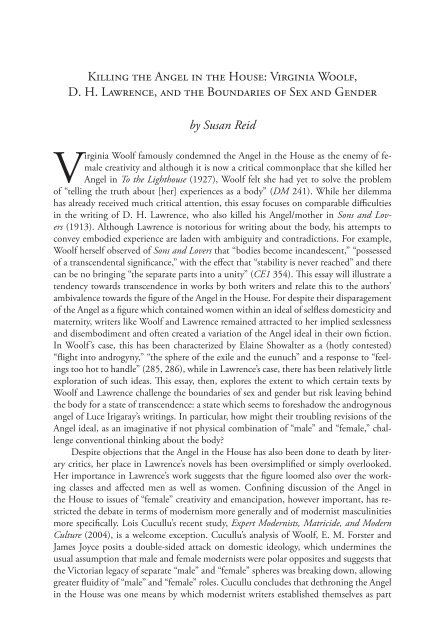Woolfian Boundaries - Clemson University
Woolfian Boundaries - Clemson University
Woolfian Boundaries - Clemson University
Create successful ePaper yourself
Turn your PDF publications into a flip-book with our unique Google optimized e-Paper software.
Killing the Angel in the House: Virginia Woolf,<br />
D. H. Lawrence, and the <strong>Boundaries</strong> of Sex and Gender<br />
by Susan Reid<br />
Virginia Woolf famously condemned the Angel in the House as the enemy of female<br />
creativity and although it is now a critical commonplace that she killed her<br />
Angel in To the Lighthouse (1927), Woolf felt she had yet to solve the problem<br />
of “telling the truth about [her] experiences as a body” (DM 241). While her dilemma<br />
has already received much critical attention, this essay focuses on comparable diffi culties<br />
in the writing of D. H. Lawrence, who also killed his Angel/mother in Sons and Lovers<br />
(1913). Although Lawrence is notorious for writing about the body, his attempts to<br />
convey embodied experience are laden with ambiguity and contradictions. For example,<br />
Woolf herself observed of Sons and Lovers that “bodies become incandescent,” “possessed<br />
of a transcendental signifi cance,” with the eff ect that “stability is never reached” and there<br />
can be no bringing “the separate parts into a unity” (CE1 354). Th is essay will illustrate a<br />
tendency towards transcendence in works by both writers and relate this to the authors’<br />
ambivalence towards the fi gure of the Angel in the House. For despite their disparagement<br />
of the Angel as a fi gure which contained women within an ideal of selfl ess domesticity and<br />
maternity, writers like Woolf and Lawrence remained attracted to her implied sexlessness<br />
and disembodiment and often created a variation of the Angel ideal in their own fi ction.<br />
In Woolf’s case, this has been characterized by Elaine Showalter as a (hotly contested)<br />
“fl ight into androgyny,” “the sphere of the exile and the eunuch” and a response to “feelings<br />
too hot to handle” (285, 286), while in Lawrence’s case, there has been relatively little<br />
exploration of such ideas. Th is essay, then, explores the extent to which certain texts by<br />
Woolf and Lawrence challenge the boundaries of sex and gender but risk leaving behind<br />
the body for a state of transcendence: a state which seems to foreshadow the androgynous<br />
angel of Luce Irigaray’s writings. In particular, how might their troubling revisions of the<br />
Angel ideal, as an imaginative if not physical combination of “male” and “female,” challenge<br />
conventional thinking about the body?<br />
Despite objections that the Angel in the House has also been done to death by literary<br />
critics, her place in Lawrence’s novels has been oversimplifi ed or simply overlooked.<br />
Her importance in Lawrence’s work suggests that the fi gure loomed also over the working<br />
classes and aff ected men as well as women. Confi ning discussion of the Angel in<br />
the House to issues of “female” creativity and emancipation, however important, has restricted<br />
the debate in terms of modernism more generally and of modernist masculinities<br />
more specifi cally. Lois Cucullu’s recent study, Expert Modernists, Matricide, and Modern<br />
Culture (2004), is a welcome exception. Cucullu’s analysis of Woolf, E. M. Forster and<br />
James Joyce posits a double-sided attack on domestic ideology, which undermines the<br />
usual assumption that male and female modernists were polar opposites and suggests that<br />
the Victorian legacy of separate “male” and “female” spheres was breaking down, allowing<br />
greater fl uidity of “male” and “female” roles. Cucullu concludes that dethroning the Angel<br />
in the House was one means by which modernist writers established themselves as part
















